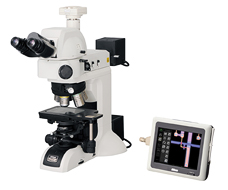Improved operability and optical performance through enhanced linkage functions with digital cameras and the newly developed CFI60-2 objectivesNikon Introduces ECLIPSE LV-N Series Industrial Microscopes
September 25, 2012

ECLIPSE LV100ND industrial microscope with optional DS-Fi2 high-definition color digital camera head and DS-L3 digital camera control unit
Nikon Corporation (Makoto Kimura, President, Tokyo,) is pleased to announce the release of ECLIPSE LV-N series of industrial microscopes on October 1, 2012, equipped with enhanced linkage functions with Digital Sight series digital cameras for microscopy and compatible with the newly developed CFI60-2 objectives.
Product Information
Product name: Nikon ECLIPSE LV-N series industrial microscopes
- Episcopic illumination models: ECLIPSE LV150NA/LV150N/LV150NL (motorized nosepiece and manual control types)
- Episcopic and diascopic illumination model: ECLIPSE LV100ND (manual control type)
Availability: From October 1, 2012
Background of Development
Industrial microscopes have been utilized for applications such as observation, examination, research, and analysis in a wide variety of fields including semiconductor, flat panel displays, electronic components, and various materials.
In these fields, a diverse range of samples are observed using various microscopic methods where both high optical performance and ease of operation are demanded.
Especially for research and analysis, further improvement has been demanded for easier operations in terms of capturing digital images and image analysis, for example.
To meet these demands, as for the ECLIPSE LV-N series, the linkage functions with Digital Sight series digital cameras has been enhanced to improve operability of the microscope combined with a digital camera.
In addition, the newly developed CFI60-2 objectives are incorporated, to further improve ease of operation attributed to the optical performance and long working distances, which are highly evaluated in the existing CFI60 objectives.
Key Features
[ECLIPSE LV-N series industrial microscopes]
- Improved operability of digital imaging
When combined with Digital Sight series digital cameras, even LV150N/LV100ND manual microscopes will allow the currently used objectives' magnification information to be detected by the digital camera control unit and displayed on the monitor through the intelligent quintuple universal nosepiece LV-NU5I and the newly developed intelligent nosepiece adapter LV-INAD. When the magnification is switched, the appropriate calibration data is automatically selected. With the LV150NA (motorized nosepiece type), objectives can be switched using the camera control unit in addition to detecting the objectives' information.
- Further advanced optical performance
By incorporating the newly developed CFI60-2 objective series to be released at the same time, the world's highest-class performance in terms of long working distances and chromatic aberration has been achieved. The result is further advancement of the CFI60 optical system, which has been highly valued because of Nikon's concept of "offering both high NA and long working distance capabilities."
- Diverse observation
The episcopic illumination models of the ECLIPSE LV-N series allow for bright-field, dark-field, simple polarization, differential interference epi-fluorescence, and two-beam interference microscopy. In addition to these methods, the episcopic illumination/diascopic illumination model supports diascopic phase contrast and diascopic differential interference microscopy. This variation enables diverse observation allowing for research, analysis, and examination that are both diversified and advanced.
<Main Specifications of ECLIPSE LV-N>
| Model | LV150N | LV150NA | LV150NL |
|---|---|---|---|
| Focusing mechanism | Uniaxial coarse/fine control knob Left: coarse/fine control Right: fine control 40 mm stroke |
||
| Epi-illuminator attachment | LV-UEPI-N/LV-UEPI2 Precentered lamphouse 12 V, 50 W |
1.1 W white LED | |
| Tube | Trinocular (upright image, number of view fields: 25/22) Trinocular tilting (upright image, number of view fields: 25/22) Binocular (inverted image, number of view fields: 22) |
Trinocular (upright image, number of view fields: 25/22) Binocular (inverted image, number of view fields: 22) |
|
| Nosepiece | Intelligent uiversal quintuple Bright field, sextuple; Bight/dark field, BD quintuple Universal, quintuple Etc. |
Motorizied universal, quintuple | Bright field, sextuple Universal, quintuple |
| Stage | 3 × 2 stage (stroke: 75 × 50 mm) 6 × 4 stage (stroke: 150 × 100 mm) 6 × 6 stage (stroke: 150 × 150 mm) |
3 × 2 stage 6 × 6 stage |
|
| Objective | CFI60-2/CFI60 objective series
|
||
| Power consumption | 1.2A/75W | 0.1A/3W | |
| Model | LV100ND |
|---|---|
| Focusing mechanism | Uniaxial coarse/fine control knob Left: coarse/fine control Right: fine control 40 mm stroke |
| Epi-illuminator attachment | LV-UEPI-N/LV-UEPI2 Precentered lamphouse 12 V, 50 W |
| Diascopic illumination section | Precentered lamphouse 12 V, 50 W (fly-eye optical system) |
| Condenser | Universal (bright/dark field, phase turret, diascopic differential interference) LWD achromat (bright field) Dark field Etc. |
| Tube | Trinocular (upright image, number of view fields: 25/22) Trinocular tilting (upright image, number of view fields: 25/22) Binocular (inverted image, number of view fields: 22) |
| Nosepiece | With status detection function, quintuple Bright field, sextuple; bright/dark field, BD quintuple Universal, quintuple Etc. |
| Stage (manual) | 3 × 2 stage (stroke: 75 × 50 mm) 6 × 4 stage (stroke: 150 × 100 mm) High-precision rotatable stage Etc. |
| Objective | CFI60-2/CFI60 objective series
|
| Power consumption | 1.2A/75W |
- This information is current as of the date of publication. It is subject to change without notice.
